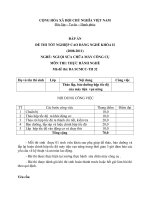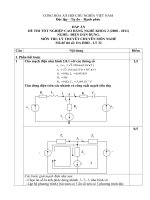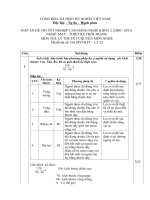CHAPTER 32
Bạn đang xem bản rút gọn của tài liệu. Xem và tải ngay bản đầy đủ của tài liệu tại đây (376.25 KB, 7 trang )
Chapter 32/A Macroeconomic Theory of the Open Economy ✦ 189
Chapter 32
A Macroeconomic Theory of the Open
Economy
1.
Households make their savings available to borrowers through
a. resource markets.
b. the loanable funds market.
c. the labor market.
d. taxes.
2.
The supply of funds curve is upward sloping because a rise in the interest rate
a. decreases the opportunity cost of firms’ investment spending.
b. increases the opportunity cost of firms’ investment spending.
c. decreases the opportunity cost to households of consuming.
d. increases the opportunity cost to households of consuming.
3.
Market clearing in the loanable funds market
a. guarantees that total spending will be just sufficient to purchase whatever output is
produced.
b. means that the interest rate will never change.
c. guarantees that total spending will equal the quantity of loanable funds demanded.
d. requires that the government run a budget deficit.
4.
Which of the following changes would cause a movement along the U.S. demand curve for a
foreign currency?
a. an increase in U.S. real GDP
b. a decrease in U.S. real GDP
190 ✦ Chapter 32/A Macroeconomic Theory of the Open Economy
c. an increase in the U.S. interest rate
d. a change in the real exchange rate
5.
As the U.S. interest rate falls relative to the British interest rate,
a. the U.S. demand curve for pounds will not change.
b. the U.S. demand curve for pounds will shift to the left.
c. the U.S. demand curve for pounds will shift to the right.
d. there will be a move down the existing U.S. demand curve for pounds.
6.
The supply of foreign exchange is
a. determined by the real exchange rate.
b. independent of the real exchange rate.
c. determined by central bankers.
d. determined by the President.
7.
Which of the following could increase the supply of dollars in the foreign exchange market?
a. lower inflation in foreign countries than in the United States
b. lower interest rates in foreign countries than in the United States
c. higher prices in the United States
d. a depreciation of other currencies
8.
Which of the following could decrease the supply of dollars in the foreign exchange market?
a. a higher inflation rate in foreign countries
b. lower interest rates in foreign countries
c. lower prices in the United States
Chapter 32/A Macroeconomic Theory of the Open Economy ✦ 191
d. an appreciation of other currencies
9.
Equilibrium in an open economy is characterized by
a. net exports = net capital outflow.
b. net exports + net capital outflow = savings.
c. domestic investment + net capital outflow = savings.
d. Both a and c are correct.
10.
The link between the loanable funds market and the foreign exchange market is
a. the governments of the countries involved.
b. the International Monetary Fund.
c. net capital outflow.
d. purchasing power parity.
11.
After reunification, Germany experienced a tremendous increase in the demand for loanable funds
as many rebuilding projects were initiated. As a result, interest rates
a. rose, there was a decrease in net capital outflow, there was a decrease in the supply of marks,
and the real exchange rate fell.
b. rose, there was a decrease in net capital outflow, there was a decrease in the supply of marks,
and the real exchange rate rose.
c. fell, there was an increase in net capital outflow, there was a decrease in the supply of marks,
and the real exchange rate rose.
d. fell, there was an increase in net capital outflow, there was an increase in the supply of marks,
and the real exchange rate fell.
12.
Japan has historically had a high savings rate relative to other countries. This means that the
a. supply of loanable funds is larger, interest rates are lower, and net capital outflow is higher.
b. supply of loanable funds is smaller, interest rates are lower, and net capital outflow is higher.
c. demand for loanable funds is larger, interest rates are lower, and net capital outflow is higher.
d. government must subsidize production in order to encourage international trade.
192 ✦ Chapter 32/A Macroeconomic Theory of the Open Economy
13.
Foreign investment in the U.S. causes the
a. balance on current account to become positive.
b. sum of the capital and current accounts to be positive.
c. balance of trade to become negative.
d. value of the dollar to increase.
14.
The “twin deficits” refer to
a. the U.S. and Canadian trade deficits.
b. the U.S. trade deficit and the U.S. federal government budget deficit.
c. the current account and capital account deficits.
d. trade deficits that match one another when two countries trade.
15.
If the United States government wants to eliminate a trade deficit, it could
a. reduce tariffs.
b. encourage imports.
c. reduce quotas on imports.
d. depreciate the dollar.
16.
Which of the following would not be an appropriate response to a trade deficit for the United
States?
a. increase tariffs
b. appreciate the dollar
c. subsidize exports
d. impose import quotas
17.
Currently, the U.S. government is running a budget deficit. This means that the
Chapter 32/A Macroeconomic Theory of the Open Economy ✦ 193
a.
b.
c.
d.
supply of loanable funds has increased.
supply of loanable funds has decreased.
real interest rate has fallen.
real exchange rate has fallen.
18.
Crowding out caused by government budget deficits will lead to
a. an increase in the real exchange rate.
b. a decrease in the real exchange rate.
c. no change in the real exchange rate.
d. a devaluation in a nation’s currency.
19.
Surprisingly, government trade policies
a. can eliminate a trade imbalance.
b. often increase a trade deficit.
c. have no real affect on the trade balance.
d. can lower a deficit on current account but not on the capital account.
20.
A tariff is a
a. tax on goods produced domestically.
b. tax on exported goods.
c. tax on imported goods.
d. limit placed on the quantity of goods that a country can import.
21.
A import quota is a
a. tax on goods produced domestically.
194 ✦ Chapter 32/A Macroeconomic Theory of the Open Economy
b. tax on exported goods.
c. tax on imported goods.
d. limit placed on the quantity of goods that a country can import.
22.
Consider this diagram of the market for foreign exchange. If the U.S. government decides to
increase import tariffs on imported steel, we could expect the
a.
b.
c.
d.
demand for dollars to shift from D1 to D2.
demand for dollars to shift from D2 to D1.
supply of dollars to increase.
supply of dollars to decrease.
23.
In response to an import quota
a. exports increase by more than imports.
b. imports increase by more than exports.
c. imports and exports are unaffected, but the government collects revenues.
d. imports and exports are both reduced but net exports are unchanged.
24.
A large and sudden movement of capital out of a country is called
a. a capital inflow.
b. capital flight.
c. a trade deficit.
d. a trade surplus.
Chapter 32/A Macroeconomic Theory of the Open Economy ✦ 195
25.
The first step to analyzing capital flight is to expect a(n)
a. increase in net capital outflow for the country experiencing the flight.
b. decrease in net capital outflow for the country experiencing the flight.
c. decrease in the supply of domestic currency for the country experiencing the flight.
d. decrease in the demand for loanable funds for the country experiencing the flight.
26.
Capital flight is often caused by
a. political stability.
b. shifts away from the industrial sector and towards the service sector.
c. political instability.
d. policies of the International Monetary Fund.









